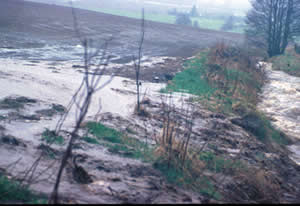 A major focus in our work on phosphorus mobilisation is on the riparian land-water interface. Narrow vegetated buffer strips along stream sides are increasingly being promoted as cost-effective for sediment trapping and riparian habitat improvement. Our work questions whether the desirable process of trapping of sediments and sediment-bound P in the buffer may lead to increasing P build-up and consequently high-risk future P source areas near to streams.
A major focus in our work on phosphorus mobilisation is on the riparian land-water interface. Narrow vegetated buffer strips along stream sides are increasingly being promoted as cost-effective for sediment trapping and riparian habitat improvement. Our work questions whether the desirable process of trapping of sediments and sediment-bound P in the buffer may lead to increasing P build-up and consequently high-risk future P source areas near to streams.
Unlike the situation for N, where pathways for loss of gaseous N forms exist, there are fewer options to remove the P that accumulates. An improved knowledge of P cycling and biogeochemistry under different buffer conditions is key to our understanding of how to manage this P and stop its release to the adjacent watercourses. Any build up of soil P status has implications for channel restoration and flood management schemes promoting naturally-eroding meanders since any transported stream bank soils would carry greater sorbed P. Our studies indicate that buffer establishment results in a transition of microbiology, vegetation and soil P balance.
The improved understanding of P cycling in such critical landscape positions will enable better management of riparian areas as they become increasingly managed. This process-based soil knowledge supports our long-term water quality and ecological monitoring in catchments with differing management. We aim to develop the understanding and tools to manage different forms of P pollution (for example inorganic, organic and particle associated) which impact on Scottish rivers with wide ranging trophic status, pressures and habitats.
Our research in this area focuses on these areas and questions:
- How do methods of riparian management influence the amount and nature of sediments transported to streams?
- What happens to all the phosphorus that accumulates in riparian buffer strips? What processes control its turnover and whether it eventually leaches to watercourses?
- Can we develop novel methods of tracing stream sediment sources using trace metal fingerprinting
Who is working in this area?
- Marc Stutter
- David Lumsdon
- Charlie Shand
- Lisa Avery
|
Updated: 23 Jan 2024, Content by: MC
|

